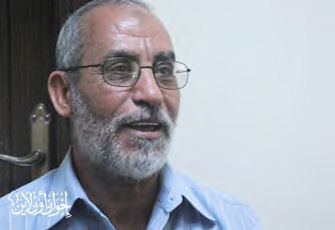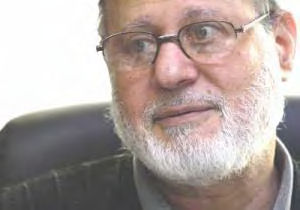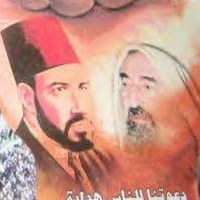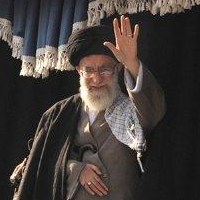![]()
Sun, June 19, 2011 | The Meir Amit Intelligence and Terrorism Information Center
The Muslim Brotherhood – Chapter 8: Profiles of prominent Muslim Brotherhood figures in Egypt
The Muslim Brotherhood is an Islamic mass movement whose worldview is based on the belief that “Islam is the solution” and on the stated aim of establishing a world order (a caliphate) based on Islamic religious law (Shariah) on the ruins of Western liberalism. With extensive support networks in Arab countries and, to a lesser extent, in the West, the movement views the recent events in Egypt as a historic opportunity. It strives to take advantage of the democratic process for gradual, non-violent progress towards the establishment of political dominance and the eventual assumption of power in Egypt and other Middle Eastern countries.
Overview
Most Muslim Brotherhood leaders and senior activists belong to the middle or upper-middle class; some come from wealthy families,[67] have university or college degrees (some even studied in the West), and have work experience in the public sector. Many of the movement’s senior officials acquired their religious education in its own religious studies system (even though there is also a group of Al-Azhar University graduates).
Guidance Office
Dr. Mohammed Badie Abd al-Majid Sami
a. Position in the movement: general guide (as of January 2010)
b. Personal background: born 1943, from Al-Mahallah al-Kubra, married and father of three, the son-in-law of the fifth general guide, Mustafa Mashhur. Has a Ph.D. in veterinary medicine from Zagazig University, worked as a lecturer in the universities of Asyut and Zagazig, resided in Yemen during the 1970s and 1980s, was chairman of the general veterinarians trade union.
c. Background in the movement: member since the 1960s; member of the Guidance Office since 1996; member of the Global Guidance Office since 2007. Arrested and served several prison sentences for his activity in the movement (the first time was in 1965-1974; the last time was for one month in 2008 during the municipal elections).
d. Ideological orientation: in his early days, he was influenced by the ideas of Sayyid Qutb. He is considered a prominent representative of the movement’s conservative school of thought. After being elected general guide, he made statements in support of Hamas’ terrorist activities and the jihad waged by “persecuted Muslims” in various arenas worldwide.
e. Other: he has yet to prove himself; it is our impression, however, that he is a lackluster, careful leader with no charisma or vision, elected as a compromise candidate between the movement’s powers.
Dr. Mahmoud Ezzat Ibrahim
a. Position in the movement: deputy general guide (as of January 2010) and head of the Da’wah Dissemination Department (as of February 2010)
b. Personal background: born 1944, Cairo, married to the sister of former general guide Mahdi Akef. Lecturer on medicine at Zagazig University, also worked as a lecturer at Sana’a University in Yemen (in the early 1980s and possibly even prior to that).
c. Background in the movement: member since 1962, elected as member of the Guidance Office in 1981 but is a permanent member since 1995. Formerly the movement’s chairman. Arrested and served several prison sentences (first in 1965-1974; the latest was for three months in 2010).
d. Ideological orientation: considered a prominent representative of the conservative school of thought.
e. Other: considered one of the most powerful, influential personalities in the movement, and the one that pulls its strings.
Dr. Jum’ah Amin Abd al-Aziz
a. Position in the movement: deputy general guide (as of January 2010); head of the Education Department and supervisor of the Muslim Sorority (as of February 2010).
b. Personal background: born 1934, Beni Suef.
c. Background in the movement: member since 1951; served as director of the International Islamic Youth Symposium in Jeddah in 1981-1985; member of the Guidance Office since 1995. One of the movement’s ideologues and historians. Arrested and served several prison sentences (the first time was in 1965-1971).
d. Ideological orientation: prominent representative of the conservative school of thought.
e. Other: known to suffer health issues.
Dr. Rashad al-Bayumi
a. Position in the movement: deputy general guide (as of January 2010); head of the Students Department (as of February 2010).
b. Personal background: born 1935, Sohag. Lecturer at the Cairo University’s Faculty of Science (specializes in geology).
c. Background in the movement: joined in 1948 during the war; worked in the UAE until 1986; member of the Guidance Office since 1995. Served a prison sentence in 1954-1971.
d. Ideological orientation: prominent representative of the conservative school of thought.
e. Other: known for his lack of organizational skills.
Dr. Khairat al-Shater
a. Position in the movement: deputy general guide (as of January 2004); currently serving a prison sentence.
b. Personal background: born 1950, Dakahlia, married to the sister of Guidance Office member Mahmoud Ghazlan; his daughter is married to the latter’s son. Has an undergraduate degree in engineering from Alexandria University and a graduate diploma in liberal arts from Al-Shams University; has a diploma in Islamic studies; studied civil society and NGO studies; apparently has a Ph.D. in computer studies from his studies in London. In addition, he has worked in commerce and has been a board member of several companies and banks. Owns over ten companies and factories (including the Salsabil computer company, associated with the 1992 affair when security forces confiscated materials on the Muslim Brotherhood and its members from the company offices). His worth is estimated at 100 million Egyptian pounds; resided in Yemen, Saudi Arabia, Jordan, and Britain, and traveled extensively to Arab, Asian, and European countries.
c. Background in the movement: officially joined in 1974; started taking part in Islamic activities as early as in 1967 (he was apparently a Nasserist in his early days); member of the Guidance Office since 1995. Detained several times (starting in 1968), notably in 1995 (for five years), and in 2007 (for seven years) on charges of financing terrorism and money laundering following the Al-Azhar militia affair in December 2006. Considered the economic brain of the movement and its main financier (second to Youssef Nada).
d. Ideological orientation: while he leans more towards the reformist school of thought in the ideological sense, in practice he occupies the middle ground between the conservatives and the reformists. Said to be “embraced by the old guard”.
e. Other: prior to his arrest, considered the movement’s strongest, most influential figure (nicknamed “Iron Man”, he was in control of the Muslim Brotherhood’s funding sources and appointed his associates to key positions). Was popular with the movement’s younger generation.
Dr. Mahmoud Hussein
a. Position in the movement: secretarygeneral (as of January 2010) and in charge of the South Upper Egypt region (as of February 2010).
b. Personal background: born 1947, Jaffa, to a Palestinian mother. Resided in Rafah. Lecturer on engineering at Asyut University.
c. Background in the movement: was a candidate to replace the fourth general guide, Abu al-Nasr, in 1996; member of the Guidance Office since 2009. Detained in 1995 and sentenced to three years in prison.
d. Ideological orientation: in our assessment, he is a member of the conservative faction.
Dr. Issam al-Din Mohammed Hussein al-Aryan
a. Position in the movement: Political Bureau chief and official spokesman (as of February 2010).
b. Personal background: born 1954, Giza. Has a first degree in medicine, a diploma in law, and a diploma in Islamic religious law from Al-Azhar University; founding member of the Egyptian human rights organization.
c. Background in the movement: apparently joined in the 1970s; founding member of Islamic educational activity in Cairo University and other Egyptian universities; was member of the People’s Assembly in 1987-1990 (representing Imbaba); one of the most prominent members who spearheaded the movement’s integration into the political system in the 1980s; was head of the Political Bureau and chief of PR under the previous general guide. Arrested and served several prison sentences (notably in 1995-2000; his latest prison sentence was for three months in 2010).
d. Ideological orientation: a notable representative of the pragmatic school of thought, even though he is able to coordinate his positions with representatives of the conservative school of thought.
e. Other: highly active and influential member of the movement; experienced, charismatic politician able to position himself as a “warrior for democracy” vis-à-vis the West; was perceived as the movement’s contact with the U.S. though he denies it.
Dr. Muhammad Saad al-Katatni
a. Position in the movement: official spokesman, in charge of the North Upper Egypt region (as of February 2010), chairman of the parliament faction (as of 2005).
b. Personal background: born 1952, has a B.A. in liberal arts and a Ph.D. in science, lecturer on botany at Al-Minya University; member of an Egyptian organization for freedoms and human rights; secretary-general of the teaching faculty club at Al-Minya University since 1990.
c. Background in the movement: co-founder of the coordination committee between parties, national factions, and trade unions; one of the leaders of the movement’s involvement in the political system; member of the Guidance Office since June 2008; the movement’s representative at international conferences outside of Egypt.
d. Ideological orientation: prominent representative of the reformist faction.
e. Other: highly active in politics.
Dr. Mohammed Mursi
a. Position in the movement: official spokesman and head of the department of trade unions (as of February 2010).
b. Personal background: apparently born in the 1950s; head of the Department of Material Engineering at Zagazig University.
c. Background in the movement: member of the People’s Assembly and chairman of the Muslim Brotherhood parliament faction (2000-2005); was not elected to the People’s Assembly in 2005; negotiated with other opposition elements (particularly the Nasserist party) ahead of the 2010 Shura Council elections.
d. Ideological orientation: according to various publications, member of the pragmatic faction.
e. Other: considered to be deputy general guide Khairat al-Shater’s confidant.
Dr. Abdul Rahman al-Bar
a. Position in the movement: the movement’s mufti (replaced Abdullah Khatib in February 2010).
b. Personal background: born in 1963, Dakahlia. Has a Ph.D. in hadith studies from Cairo University, lecturer on hadith science at Al-Azhar University.
c. Background in the movement: member of the Guidance Office since 2009; preaches to Islam abroad. Detained in 2008 on charges of funding and transferring weapons to Hamas.
d. Ideological orientation: apparently leans towards the conservative faction.
Dr. Osama Nasr al-Din Mohammed Mustafa
a. Position in the movement: head of the Muslim Brotherhood’s administrative development department.
b. Personal background: born in 1956, Alexandria. Lecturer on microbiology at Alexandria University.
c. Background in the movement: served as chairman of the movement’s administrative office in Alexandria; member of the Guidance Office since 2008. Frequently arrested since 1995 (the last time was in 2010).
Engineer Saad Ismat Mohammed al-Husseini
a. Position in the movement: member of the Political Bureau (as of 2010) and member of the Muslim Brotherhood faction in the People’s Assembly for the provinces of Al-Gharbiyya and Al-Mahallah al-Kubra (as of 2005); deputy spokesman for the faction.
b. Personal background: born in 1959, engineer by trade.
c. Background in the movement: member of the Guidance Office since 2008; was involved in promoting contacts with other opposition elements (particularly the Al-Ghadd party) for the 2010 Shura Council elections. Detained in 1995 and acquitted; detained several times during the last decade.
d. Ideological orientation: in our assessment, belongs to the reformist faction.
Dr. Mohammed Abdul Rahman al-Mursi
a. Position in the movement: in charge of the Central Delta region (as of February 2010).
b. Personal background: born in 1956, Dakahlia. Cardiovascular specialist.
c. Background in the movement: served as deputy chief of the Muslim Brotherhood administrative office in Dakahlia Province. Arrested several times (most notably in 2004).
Dr. Mahmoud Ahmed Abu Zaid
a. Position in the movement: in charge of the Greater Cairo region (as of February 2010).
b. Personal background: born in 1956. Has a Ph.D. in vascular surgery; lecturer, Faculty of Medicine, Cairo University.
c. Background in the movement: member of the Guidance Office since 2009. Detained in 2006 and recently released.
Dr. Mahmoud Sayyid Abdullah Ghazlan
a. Background in the movement: former secretary-general (up to his arrest in 2001; released in 2005); rejoined the Guidance Office in 2009. Last arrested in 2007.
b. Personal background: apparently of the same age as general guide Badie and his deputy, Mohammed Ezzat; has family ties to Khairat al-Shater, the deputy general guide. Lecturer, Faculty of Agriculture, Zagazig University.
c. Ideological orientation: member of the conservative school of thought.
d. Other: mentioned in July 2008, with Mahmoud Ezzat and Sabri Arafa, as a powerful personality in control of the movement.
Dr. Muhyi Hamed Mohammed al-Sayyid
a. Position in the movement: in charge of the East Delta region (as of February 2010).
b. Personal background: born in 1960, Suez. Has a B.A. in medicine and surgery from Zagazig University, currently a consultant in ear, nose and throat medicine.
c. Background in the movement: deputy secretary-general in the Al-Sharqiyya Province, deputy chairman of the Alexandria administrative office, member of the Guidance Office since 2008. Arrested several times since 1992.
Dr. Mustafa Taher al-Ghneimi
a. Position in the movement: in charge of the West Delta region (as of February 2010).
b. Personal background: born in 1955, Gharabiyya. Gynecology specialist; served as chairman of the association of Gharabiyya doctors.
c. Background in the movement: member of the Guidance Office since 2009. Arrested several times (notably in 1999, over the trade unions affair).
Dr. Mohammed Ali Bashar
a. Position in the movement: honorary member of the Guidance Office.
b. Personal background: born in 1951, Manufiya. Lecturer, Faculty of Engineering, Manufiya University. Since 1997 serves as chairman of the regional office of the Federation of Engineering Institutions in Islamic Countries (FEEIC).
c. Background in the movement: joined in 1979, ran several times (including in 1995) for the People’s Assembly but failed due to the regime’s involvement; served as head of the Islamic education association in Manufiya and head of the Islamic equality and charity association; took part in international conferences on behalf of the Muslim Brotherhood; in 2005 was the movement’s spokesman in Egypt and elsewhere; rejoined the Guidance Office in 2009 (his name was removed from the Guidance Office in 2008 following his arrest); arrested again in 1999 over the trade unions affair and released in 2002.
d. Ideological orientation: apparently affiliated with the reformist school of thought.
Prominent members of the organization’s parliament faction
Mohammed al-Baltaji — chairman of the Muslim Brotherhood parliament faction (in 2005-2010) and one of the most active parliament members (for the province of Qalyubia, Shubra al-Khaymah). Staunch activist against the blockade on the Gaza Strip. In 2009-2010, was involved in organizing humanitarian aid convoys in protest against the construction of the steel wall along the Gaza Strip-Egypt border by the Egyptian regime. Was one of the two Egyptian parliament members who took part in the Turkish flotilla to the Gaza Strip and were present aboard the Mavi Marmara (May 2010). He was a strong critic of hereditary power transfer (by President Mubarak), has written articles criticizing the regime’s policy in oppositionist/independent media. At the same time, he supported the Muslim Brotherhood’s non-participation in presidential elections and its choice not to support other presidential candidates, as well as to settle for only 20 percent of the seats in the People’s Assembly — at least for the two next terms, while focusing on social activity.
Hussein Mohammed Ibrahim — deputy chairman of the Muslim Brotherhood parliament faction (in 2005-2010).
Jamal Nassar — spokesman for the movement’s faction in the People’s Assembly, owns and runs the Muslim Brotherhood website, at times
considered the movement’s media advisor.
Hamdi Hassan — spokesman for the movement’s faction in the People’s Assembly (in 2005-2010).
Hazem Farouk — active member of the Muslim Brotherhood parliament faction (in 2005-2010, representative of the North Coast). With Mohammed al-Baltaji, was involved in activities to lift the blockade on the Gaza Strip, including participation in the Marmara flotilla (May 2010).
Other prominent Muslim Brotherhood activists
Dr. Mohammed al-Sayyid Habib (born 1943) — formerly deputy general guide, during which time he was considered one of the movement’s most powerful personalities (together with Mahmoud Ezzat and Khairat al-Shater) and even a leading candidate to replace Mahdi Akef as general guide. Within the movement, Habib was perceived as a self-serving manipulator who had no qualms about exposing internal differences of opinion and his personal criticism of the general guide’s performance to the media. As a result of escalating conflicts with other elements in the Muslim Brotherhood leadership, he was not elected to the Guidance Office (December 2009), as a result of which he announced his retirement from all of the posts in which he served, although he remained a member of the organization’s Shura Council. Habib called for a “division of authority” in the movement and for a reduction of the unlimited control exercised by the Guidance Office. So far, he has been unable to bring together a front to support his ideas. As for his ideological orientation, Habib has positioned himself in the middle ground between the conservatives and the reformists.
Abd al-Mun’im Abul Futuh (born 1950) — one of the most prominent leaders of the organization’s pragmatic school of thought, popular with the young activists; supports the idea of turning the movement into a party; holds pragmatic and open-minded views (for example, does not rule out women and Copts as presidential candidates) and fervently supports the increase of the Muslim Brotherhood’s political activism (including by strengthening cooperation with other opposition elements). Already in 2002, Abul Futuh was mentioned as a candidate for senior posts in the organization, such as general guide, deputy general guide, and the movement’s spokesman; however, he has systematically lost to stronger candidates from the older generation (Ma’mun al-Hudaybi, Mahdi Akef, etc.). In the latest elections (December 2009), Abul Futuh was not reelected to the Guidance Office and is currently only a member of the movement’s Shura Council.
Youssef Mustafa Nada — a millionaire, probably also as a result of arms trade. Already in the 1990s, he was known as a supporter of the Muslim Brotherhood from abroad. Was president of the Islamic Al-Taqwa Bank, whose assets were frozen by the Americans in late 2001 on charges of money laundering and suspected terrorism financing. Has been operating outside of Egypt since 1954, facilitating Muslim Brotherhood activities worldwide, mostly in Europe. Currently considered the movement’s commissioner on foreign relations. It appears that he has constant contacts with the Muslim Brotherhood in Egypt.
Mohammed Jamal Hashmat — elected to the People’s Assembly (for Damanhour, Al-Bahira); his membership was terminated in December 2002 when the Supreme Court found his election to be illegal; ran again in the 2003 elections but lost to a candidate of the Al-Wafd party (apparently with the regime’s assistance); in the 2005 elections he lost to Democratic Party candidate Mustafa al-Faqi. Was not reelected to the organization’s Guidance Office in the previous round of appointments/elections that took place in June 2008. Belongs to the reformist school of thought and is an associate of Issam al-Aryan.
Ibrahim Zaafrani — from Alexandria, apparently affiliated with the pragmatic school of thought, a close associate of Issam al-Aryan, Jamal Hashmat, and the like, and is similarly a member of the doctors’ union. In 2002 he was mentioned as a potential candidate for deputy general guide.
Mokhtar Noh (born 1953) — lawyer by trade, served as treasurer for the lawyers’ union, a supporter of Issam al-Aryan, one of the candidates for deputy general guide in 2002. Muslim Brotherhood elements were not pleased with his release from prison in August 2002 due to his public support of reevaluating the movement’s principles. In the past (April 2004), he became involved in a conflict with the movement over his substitution as the Muslim Brotherhood’s representative at the lawyers’ union following his arrest, and over his establishment of a center for human rights and liberal studies in addition to his work in the movement.
Sabri Arafa — former member of the Guidance Office (2004-2009), a post to which he was appointed by Khairat al-Shater (who chose him over Issam al-Aryan); was apparently a close associate of Mahmoud Ezzat and Mahmoud Ghazlan; according to one report, the three are members of the core group that actually controls the movement.
Lashin Abu Shanb (born 1927) — was a candidate for general guide in 2004. Considered one of Khairat al-Shater’s most important people in the Guidance Office; however, his activity was apparently terminated due to health issues and he was not elected to the Guidance Office in the latest elections (December 2009).
Sheikh Abdullah al-Khatib (born 1931) — the movement’s former mufti and member of the Guidance Office until his resignation in November 2008, apparently due to health issues. Was mentioned as a possible candidate for general guide in 2004. Al-Khatib holds conservative and radical views, preaching for the destruction of existing churches and the cessation of construction of new ones, and is opposed to the election of Copts and women to senior posts.
Mohammed Mahdi Akef (born 1928) — the movement’s seventh general guide and the first in history to voluntarily step down while still alive. Considered a weak, uncharismatic general guide elected as compromise candidate. Was member of the “secret apparatus” and even involved in Nasser’s assassination attempt; his views became more moderate following a long prison sentence. While he belongs to the conservative school of thought, he has often “flip flopped” between it and representatives of the movement’s reformist school of thought. His rash hawkish statements about the regime were cause for severe internal criticism of his performance. His term as general guide was rife with internal conflicts in the Muslim Brotherhood that also leaked to the media. His weak performance was apparently the reason he stepped down. He is currently a member of the movement’s Shura Council.
Abd al-Mun’im al-Maqsud — a Muslim Brotherhood attorney in Egypt.
This comprehensive analysis of the Muslim Brotherhood (by ITIC) consists of 12 chapters. All 12 chapters are listed below:
Chapter 1: The historical evolution of the Muslim Brotherhood in Egypt
Chapter 2: The ideology of the Muslim Brotherhood
Chapter 3: The Muslim Brotherhood’s education, preaching, and social activity
Chapter 4: The structure and funding sources of the Muslim Brotherhood
Chapter 6: The Muslim Brotherhood’s stance on the Palestinian-Israeli conflict
Chapter 7: The development of political discourse in the Muslim Brotherhood and the 2007 election platform
Chapter 8: Profiles of prominent Muslim Brotherhood figures in Egypt
Chapter 9: The Egyptian Muslim Brotherhood’s ties to its branches in Middle Eastern and Western countries
Chapter 10: The Muslim Brotherhood in other Arab countries and in Europe
Chapter 11: A profile of Sheikh Dr. Yusuf al-Qaradawi
Chapter 12: Islamic jihadist organizations in Egypt ideologically originating in the Muslim Brotherhood
You can download the full study in PDF-format here
Notes:
[67] For example, Umar al-Tilmisani, the third general guide, was born to an Algerian family that had immigrated to Egypt in the 19th century and built its wealth in real estate. Abu al-Nasr, the fourth general guide, came from one of the richest, most influential families in Asyut Province.



 RSS
RSS



































Profiles of prominent Muslim Brotherhood figures in #Egypt | #Islamism http://bit.ly/p8u1vl
Profiles of prominent Muslim Brotherhood figures in #Egypt | #Islamism http://bit.ly/p8u1vl
Profiles of prominent Muslim Brotherhood figures in #Egypt | #Islamism http://bit.ly/p8u1vl
[…] Chapter 8: Profiles of prominent Muslim Brotherhood figures in Egypt […]